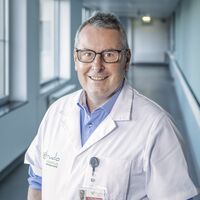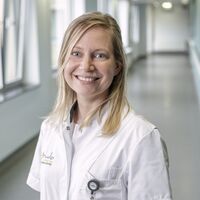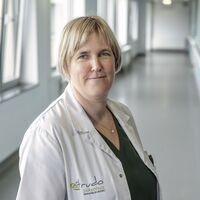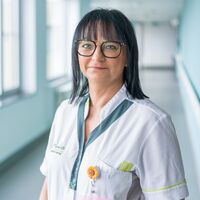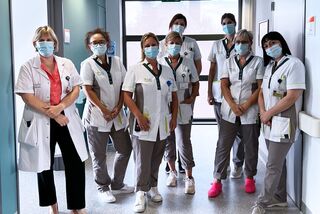Sleep lab
A multidisciplinary team consisting of a pneumologist, neurologist, nose-throat-ear doctor and dentist is responsible for diagnosing and treating people with sleep and wakefulness disorders.
What can we help you with?
Good sleep is essential to function well physically and mentally. The consequences of sleep deprivation are still too often underestimated: increased risk of traffic and work accidents with often disastrous consequences; increased prevalence of obesity, diabetes mellitus and hypertension (metabolic syndrome). It is therefore justified that in recent decades there has been more attention to sleep and sleep disorders in the medicine field but also in the media.
In Sint-Trudo Hospital the sleep lab is a collaboration between pneumology (pulmonary diseases) and neurology.
Respiratory-related sleep disorders
The pneumologist (pulmonologist) specializes in the 'breathing-related sleep disorders'. This is a spectrum of disorders ranging from simple snoring to sleep apnea. Sleep apnea usually occurs in loud snorers who regularly stop breathing during the night as a result of airway closure: obstructive sleep apnea syndrome (OSAS). This disrupts sleep, making you feel tired and sleepy during the day. In addition, with moderate to severe sleep apnea, there may be an increased risk of cardiovascular disease.
During a sleep study (polysomnography) we study the sleep quality and the way you breathe at night. This examination is essential for the diagnosis and choice of treatment for breathing-related sleep disorders.
The doctor will discuss treatment with you. For severe forms of sleep apnea, CPAP therapy is the preferred treatment. A CPAP device blows air under light pressure through a mask placed on the nose. In this way, the device prevents the airway from closing at the level of the throat. This negates the negative effects of sleep apnea.
Other possible treatments for sleep apnea include:
- Mouth/Oral prosthesis or MRA (mandibular repositioning device): If you have healthy teeth, in some cases of moderate sleep apnea, a prosthesis can be provided that moves the lower jaw into a forward position. Thus, the pharynx is widened during sleep. This treatment is discussed at the multidisciplinary consultation where the pulmonologist, ENT specialist and dentist (affiliated with the hospital) work together. For this, Sint-Trudo works with dentist Christophe Jacobs.
Possible treatments for snoring or mild forms of sleep apnea:
- Somnoplasty: Under local anesthesia we will heat the palate resulting in scarring. In this way, the palate stiffens and in some cases this can offer a solution for the problem.
- Uvulopalatopharyngoplasty (UPPP): This is a surgical procedure, in which the tonsils and part of the uvula are removed. The doctor makes an incision in the soft palate and performs a kind of lifting .
The central sleep apnea syndrome is less common. At periods, the brain does not transmit a stimulus to the respiratory muscles, causing breathing to temporarily stop. When diagnosing this condition, we must rule out an underlying cardiac or neurological problem.
Sleep disorders of a neurological nature
Common:
- Insomnia or insomnia: difficulty falling asleep and/or staying asleep, early awakening
- Parasomnia: this occurs in forms such as sleepwalking, talking during sleep, teeth grinding,...
- Circadian rhythm disorders: e.g. jet lag or shift in working hours can cause sleep disturbances.
For this, a sleep study (polysomnography) is not always appropriate. Optimizing sleep hygiene is an important part of treatment here. Referral to a sleep psychologist for cognitive behavioral therapy may be necessary.
Less frequent sleep disorders of a neurological nature:
- 'Periodic limb movements' syndrome (PLMS)
This manifests itself in involuntary limb movements during the night resulting in interrupted sleep. As a result, you experience symptoms of excessive sleepiness. PLMS can coexist with 'restless legs' syndrome (RLS). In PLMS without typical syndromes of RLS, neurological follow-up and a sleep study (polysomnography) are indicated. - Narcolepsy
This is a rare neurological disorder that usually starts at a younger age. The condition is characterized by a general drowsiness, with sometimes an uncontrollable urge to fall asleep. Narcolepsy may also involve muscle weakness for a few seconds or minutes, especially after a violent emotion, such as laughter or a tantrum. Narcolepsy patients also sometimes suffer from sleep paralysis, which are short periods of paralysis that occur mainly upon falling asleep or waking. Sleep paralysis can be very frightening, especially if accompanied by the feeling of not being able to breathe or hallucinations.
